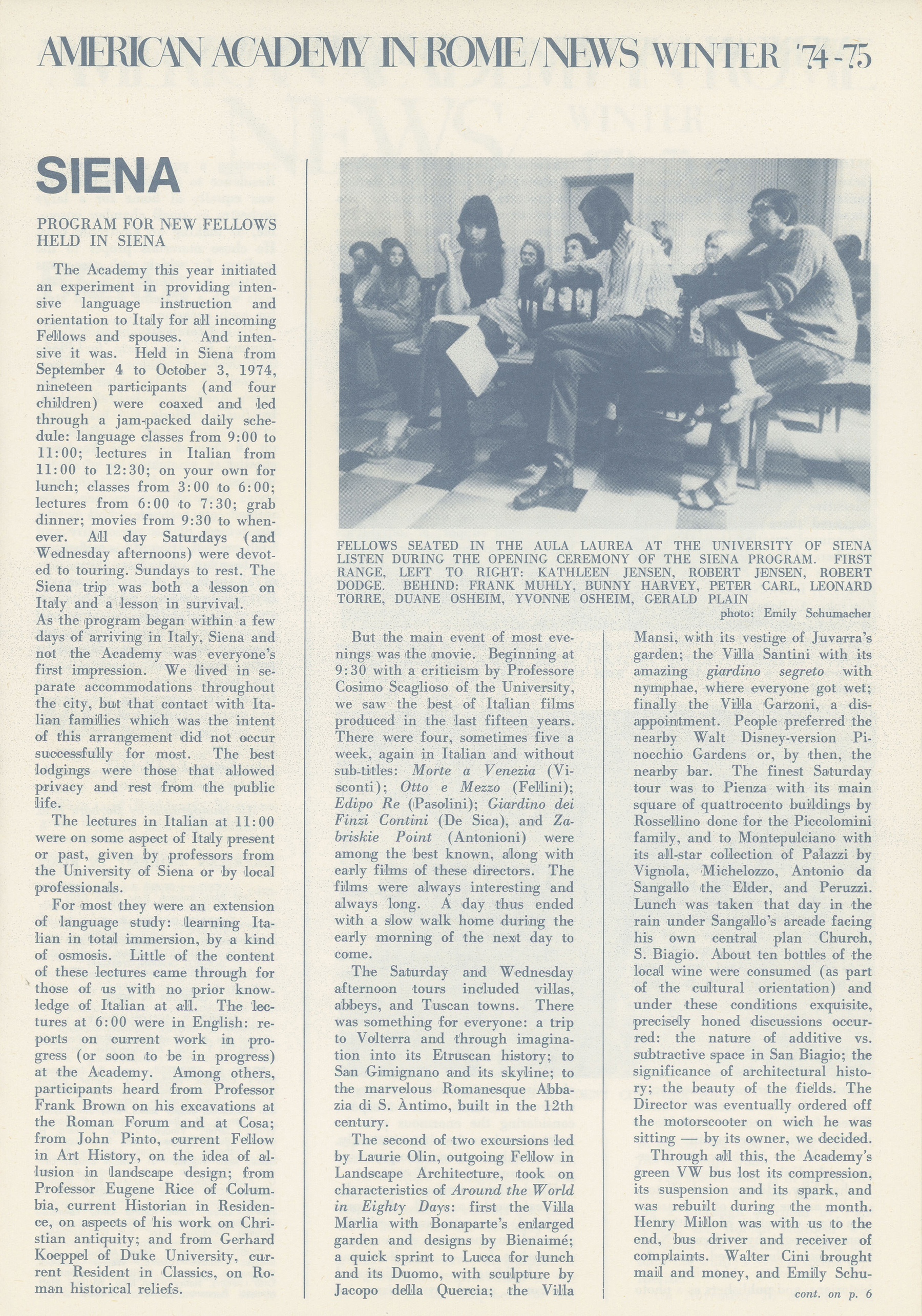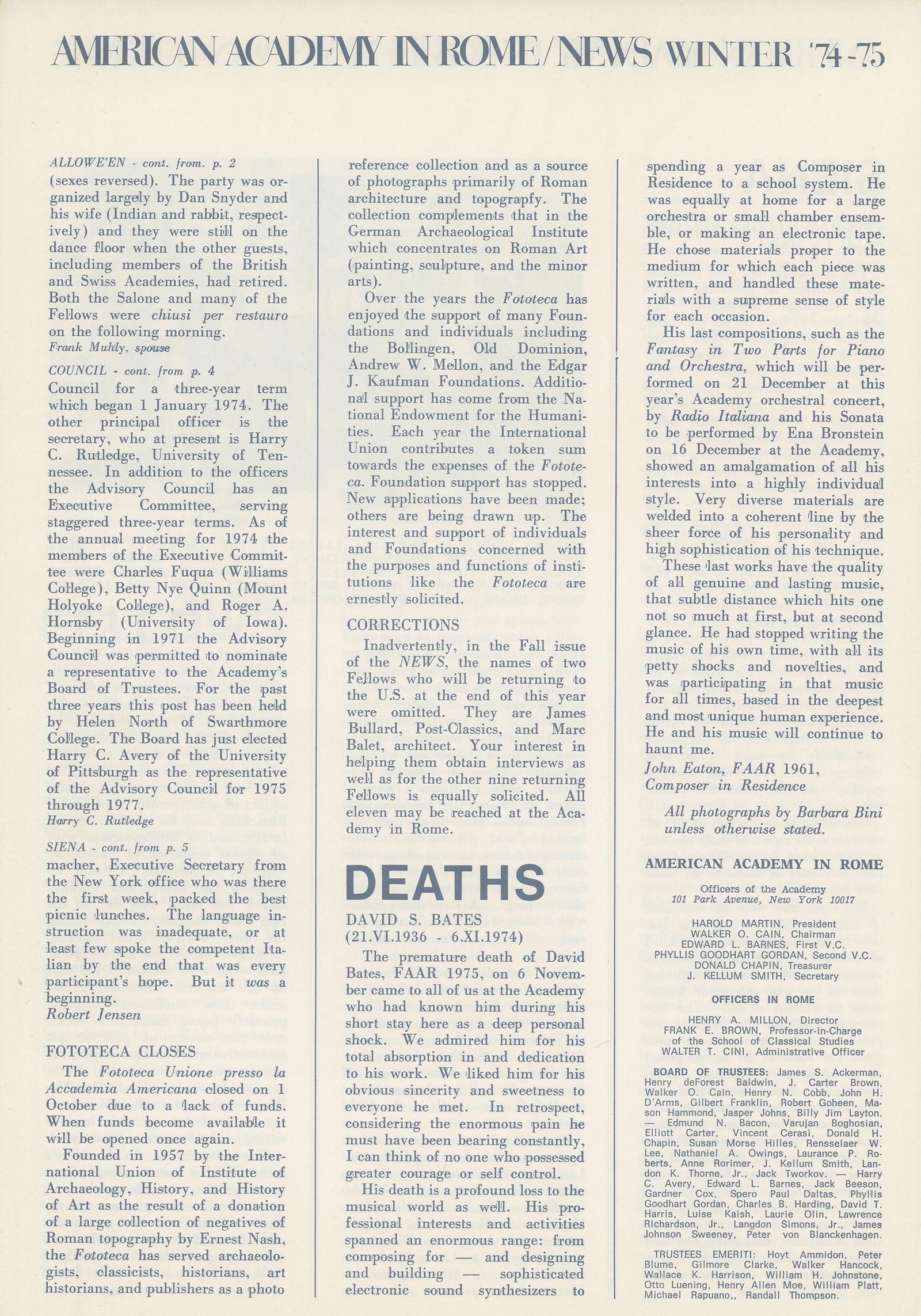In September 1974, the American Academy piloted a language and cultural orientation program for new Rome Prize Fellows, in partnership with the University of Siena. Under the new program, fellows and their families spent the first month of their fellowship in Siena where they attended language lessons, lectures on Italian art and history, and tours of cultural sites across Tuscany. Guest lecturers included Carlo Bertelli, Frank E. Brown, John Eaton, Gerhard Koeppel, John Pinto, and Eugene Rice. The landscape architect Laurie Olin, an Academy Fellow from 1974, was recruited to guide visits to local Italian villas. In the evenings, fellows attended a program of Italian cinema presented with commentary from Cosimo Scaglioso, a critic and film historian.
Reception of the Siena program was positive, if mixed, with most criticisms targeted at the quality of the language courses. According to the 1975 Annual Report, “As is well known, the language, landscape, cityscape, food, wine, and the Sienese people make Siena an ideal spot for such an introductory program. With the exception of the language training, which fell short of current standards in the U.S., the program was intensive and, if the Fellows’ reports are to be believed, exhausting.”
After returning for a second year in September 1975, the Siena program was suspended in 1976 due to lack of funds.
Robert Jensen, a 1976 Fellow in environmental design, reported on the Siena program for the Winter ’74–75 Academy Newsletter, reproduced below.


Program for New Fellows Held in Siena
The Academy this year initiated an experiment in providing intensive language instruction and orientation to Italy for all incoming Fellows and spouses. And intensive it was. Held in Siena from September 4 to October 3, 1974, nineteen participants (and four children) were coaxed and led through a jam-packed daily schedule: language classes from 9:00 to 11:00; lectures in Italian from 11:00 to 12:30; on your own for lunch; classes from 3:00 to 6:00; lectures from 6:00 to 7:30; grab dinner; movies from 9:30 to whenever. All day Saturdays (and Wednesday afternoons) were devoted to touring. Sundays to rest. The Siena trip was both a lesson on Italy and a lesson in survival.
As the program began within a few days of arriving in Italy, Siena and not the Academy was everyone’s first impression. We lived in separate accommodations throughout the city, but that contact with Italian families which was the intent of this arrangement did not occur successfully for most. The best lodgings were those that allowed privacy and rest from the public life.
The lectures in Italian at 11:00 were on some aspect of Italy present or past, given by professors from the University of Siena or by local professionals.
For most they were an extension of language study: learning Italian in total immersion, by a kind of osmosis. Little of the content of these lectures came through for those of us with no prior knowledge of Italian at all. The lectures at 6:00 were in English: reports on current work in progress (or soon to be in progress) at the Academy. Among others, participants heard from Professor Frank Brown on his excavations at the Roman Forum and at Cosa; from John Pinto, current Fellow in Art History, on the idea of allusion in landscape design; from Professor Eugene Rice of Columbia, current Historian in Residence, on aspects of his work on Christian antiquity; and from Gerhard Koeppel of Duke University, current Resident in Classics, on Roman historical reliefs.
But the main event of most evenings was the movie. Beginning at 9:30 with a criticism by Professore Cosimo Scaglioso of the University, we saw the best of Italian films produced in the last fifteen years. There were four, sometimes five a week, again in Italian and without sub-titles: Morte a Venezia (Visconti); Otto e Mezzo (Fellini); Edipo Re (Pasolini); Giardino dei Finzi Contini (De Sica), and Zabriskie Point (Antonioni) were among the best known, along with early films of these directors. The films were always interesting and always long. A day thus ended with a slow walk home during the early morning of the next day to come.
The Saturday and Wednesday afternoon tours included villas, abbeys, and Tuscan towns. There was something for everyone: a trip to Volterra and through imagination into its Etruscan history; to San Gimignano and its skyline; to the marvelous Romanesque Abbazia di S. Antimo, built in the 12th century.
The second of two excursions led by Laurie Olin, outgoing Fellow in Landscape Architecture, took on characteristics of Around the World in Eighty Days: first the Villa Marlia with Bonaparte’s enlarged garden and designs by Bienaimé; a quick sprint to Lucca for lunch and its Duomo, with sculpture by Jacopo della Quercia; the Villa Mansi, with its vestige of Juvarra’s garden; the Villa Santini with its amazing giardino segreto with nymphae, where everyone got wet; finally the Villa Garzoni, a disappointment. People preferred the nearby Walt Disney-version Pinocchio Gardens or, by then, the nearby bar. The finest Saturday tour was to Pienza with its main square of quattrocento buildings by Rossellino done for the Piccolomini family, and to Montepulciano with its all-star collection of Palazzi by Vignola, Michelozzo, Antonio da Sangallo the Elder, and Peruzzi. Lunch was taken that day in the rain under Sangallo’s arcade facing his own central plan Church, S. Biagio. About ten bottles of the local wine were consumed (as part of the cultural orientation) and under these conditions exquisite, precisely honed discussions occurred: the nature of additive vs. subtractive space in San Biagio; the significance of architectural history; the beauty of the fields. The Director was eventually ordered off the motorscooter on which he was sitting—by its owner, we decided.
Through all this, the Academy’s green VW bus lost its compression, its suspension and its spark, and was rebuilt during the month. Henry Millon was with us to the end, bus driver and receiver of complaints. Walter Cini brought mail and money, and Emily Schumacher, Executive Secretary from the New York office who was there the first week, packed the best picnic lunches. The language instruction was inadequate, or at least few spoke the competent Italian by the end that was every participant’s hope. But it was a beginning.
Robert Jensen
Download the daily itinerary (and more) for the Siena orientation program.
